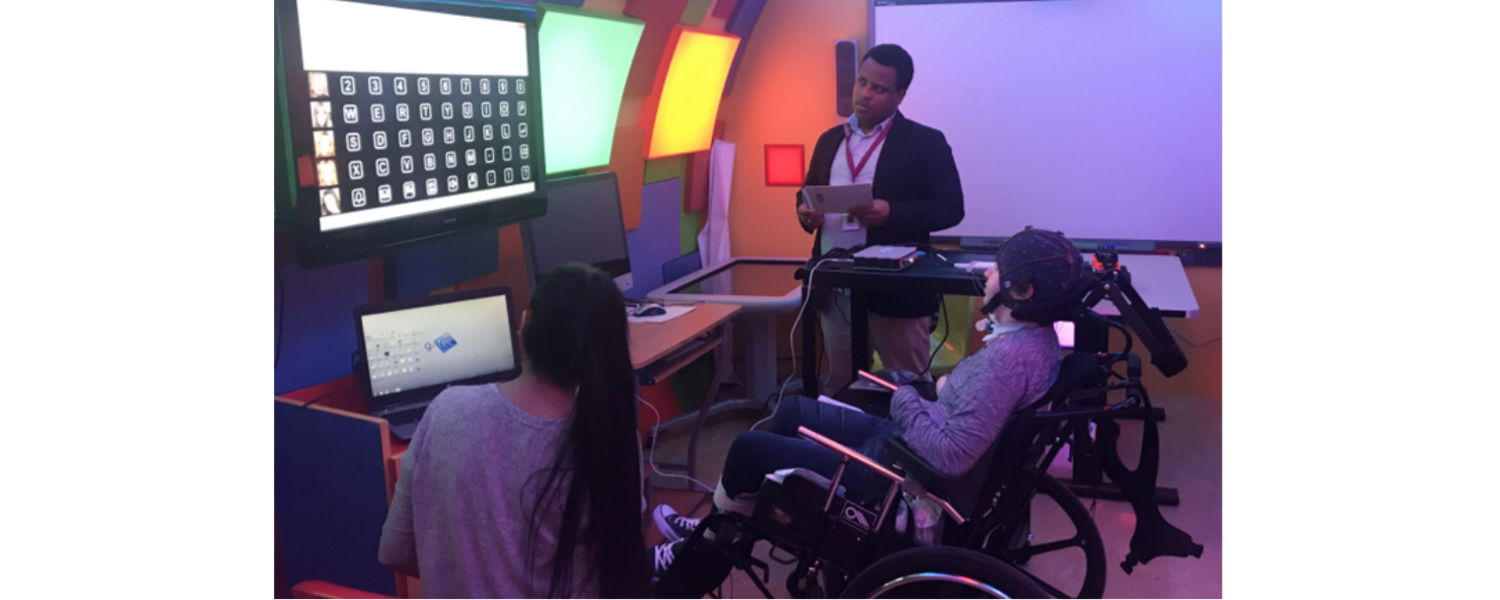
Research Projects
Brain-computer interface (BCI) technology is an exciting field, with vast potential as an access technology for people with disabilities. However, to date there has been very little research investigating BCI technology for children. Our research is centered around adapting BCI technology for pediatric users, especially for those with neurological disabilities. We want to answer fundamental questions such as how and why BCIs work for children, how to adapt different common paradigms, training methods, and applications, and how to optimize signal processing algorithms for pediatric users.
In parallel with these technical questions, we are seeking to transition BCI technology out of the laboratory, into a clinical setting, and even at home and in the community. With this part of our research, we are investigating how to adapt BCI for long-term use, how children learn how to use BCI technology and progress over time, and how BCI can best be implemented to increase interaction, independence and control for the children we work with.
Our research group is unique, bringing together researchers with backgrounds in neuroscience, engineering, medicine and rehabilitation sciences. We are proud to work with a variety of other researchers within the University of Calgary and Alberta Children's hospital, as well as with groups at the University of Alberta, University of Toronto, and the NCAN Centre in Albany, New York.
Current Research Projects
Expand the menu items below to learn more about some of our current research projects.
Project Leads(s): Adam Kirton & Alicia Hilderley
The BCI@home trial will implement and assess the impact of community-based, personalized BCI solutions for children living with severe disabilities. Families will first complete an in-person visit to review available activities, set their first goals, and learn to use BCI independently. Following this, families will take their BCI home for 3-6 months to participate in activities meaningful to them. They will be supported with weekly virtual sessions and via a messaging application. This program is the first in the world to create equitable opportunities for children with severe disabilities to use BCI in their home, school, and community.
Project Lead(s): Daniel Comaduran Marquez
Engaging in play with children with similar capabilities stimulates a sense of belonging and can lead to feelings of support, inclusion, and capability, especially for children with disabilities. Sports participation is an activity that facilitates the development of peer relationships. However, due to their severe motor impairments, children with quadriplegic CP are generally unable to participate in traditional sports and are therefore deprived of the opportunity to learn social sportsmanship skills. Boccia is a paralympic sport, one of the few that has been adapted for individuals with severe disabilities. In its most adaptive form, the player instructs an assistant to aim a ramp. After the ramp is positioned, the player drops or pushes the ball down the ramp and towards the objective ball. The objective of this project is to develop and validate a BCI-controlled Boccia ramp that enables children with sever physical disabilities to participate in a paralympic sport for the first time in their lives.
Project Lead(s): Brian Irvine
Our team is using transfer learning to make brain–computer interfaces (BCIs) faster and easier for kids to use. This technology helps BCIs “learn from experience,” so they don’t have to start learning from scratch with every new child. By sharing knowledge across users, transfer learning can shorten setup times and make BCIs more accurate and dependable. This means that children spend less time helping the BCI to learn, and more time communicating, playing, and exploring new possibilities with their minds.
Project Lead(s): Adam Luoma
Many of the children we work with want to express themselves and connect with others through playing music. Unfortunately the most accessible music making tools are not fit for their needs, further isolating these children from participation. The BCI Music project seeks to connect with children and their families, soliciting their unique needs, and building a system for them. We are using simple headsets and users attentive listening to create an easy to use and low barrier to entry application to make music. The goal of this project is to give all children the opportunity to express themselves, connect with others, and have fun through playing music.
Project Lead(s): Helen Carlson
Children with quadriplegic cerebral palsy (QCP) often can’t move or interact with the world on their own, it’s like they are “locked” inside their bodies. Brain-computer interfaces (BCIs) could help by letting them communicate and control things using only their minds. So far, no one has used brain imaging to study these childrens' unique brain signals. This project uses MRI scans to take pictures of the brains of children with QCP to learn how their brains work and how they’ve changed after early injury. This information may help us design BCIs that work better for each child based on their individual brain features.
Project Lead(s): Emily Schrag
The SSVEP Personalization Pipeline project aims to make visual BCI systems more comfortable for children to use. Some visual BCIs, called SSVEP-based BCI systems, use flashing stimuli which can sometimes feel uncomfortable—like looking at a strobe light. The SSVEP Personalization Pipeline project personalizes these visual stimuli for each individual, finding a balance between comfort and strong brain signal detection. To test this, children play a BCI-controlled game using both standard and personalized visual stimuli. By improving comfort, this research helps make BCI technology more accessible and enjoyable for children who rely on it.
Project Lead(s): Mohammadreza Behboodi
Because brain electrical activity (EEG) varies between people and even from session to session, most brain–computer interface (BCI) systems require users to complete a short training session called calibration before use. This process can be tiring and boring, especially for children. Our research aims to reduce or remove this calibration step by using foundation models — very large neural network models that can learn from data collected from many users. Once trained, these models can be applied directly to new users, allowing children to use BCI systems immediately without extra preparation.
Past Research Projects
Expand the menu items below to learn more about some of our completed research projects.
Perinatal stroke can lead to lifelong motor impairments, but even small functional gains can significantly improve independence and quality of life. To make rehabilitation more engaging, we worked with youth patient partners to develop a brain-computer interface with functional electrical stimulation (BCI-FES) system integrated with social media. In this pilot study, twelve participants aged 10–23 years with hemiparesis completed three sessions using EEG-based BCI control paired with FES-assisted movements. Most sessions achieved a high number of repetitions per hour and no adverse events were reported. Qualitative feedback indicated greater motivation and enjoyment compared to traditional therapies, supporting the feasibility of social-media-integrated BCI-FES for pediatric neurorehabilitation and guiding future clinical trials.
Project Lead(s): Dion Kelly
In order to develop brain-computer interface applications for children with neurological disabilities, it is essential that we understand and characterize how neurotypical children can use common BCI systems. This study first examines a large sample of typically developing children will undergo a series of the most common BCI paradigms, including P300 and motor imagery. This study will allow us to identify key differences, challenges, limitations and considerations with pediatric BCI compared to what is known for the adult population, and serve as a baseline from which we can measure BCI performance of children with neurological disabilities. Then, BCI paradigms will be optimized through gamification of training paradigms and protocols to investigate how BCI can be better designed for pediatric users, maintaining their motivation and attention throughout BCI use.
Relevant Publications:
Evaluating If Children Can Use Simple Brain Computer Interfaces.
Project Lead(s): Erica Floreani & Danette Rowley
The ability to move independently and explore the environment contributes significantly to development. Children with physical disabilities are often not able to move on their own, remaining passive observers of their environment and relying on caregivers to move them from place to place. Power mobility devices like powered wheelchairs can give these children the ability to move independently. We are exploring if BCI can be used as a technology to access and 'drive' power mobility devices for children with severe physical impairments who may have had limited success with more common access methods like joysticks or switches. We have recently launched a longitudinal study called BCI-Move that will follow 30+ children across 4 sites (in Canada and abroad) as they train their BCI and power mobility skills to achieve functional and personal power mobility goals.
Relevant Publications:
Project Lead(s): Dion Kelly, Erica Floreani & Danette Rowley
Most of BCI research is conducted in the laboratory, with typically developed adults. We are changing this by establishing a clinical research program to provide children with physical disabilities access to BCI technologies, and exploring how they can use these technologies to accomplish personal goals. During the COVID-19 pandemic, we brought the clinical BCI program right into the homes of our participants, so they could continue using BCI while in-person operations were suspended. Based on the initial success of this program, we are continuing to develop our home-based efforts, discovering new ways to support and study how children use BCI in a natural environment!
Relevant Publications:
Iterative Development of a Software to Facilitate Independent Home Use of BCI Technologies for Children with Quadriplegic Cerebral Palsy
Project Lead(s): Eli Kinney-Lang & Dion Kelly
Every child has the right to play, and for many children, the 'play' involves gaming - video games, online games, board games, etc. However, for the children we work with, traditional video game controllers are highly inaccessible, and even if using alternative access technologies like adaptive controllers or switches, many video games are not designed to be accessible. We are very interested to see how BCI can be used to access video games, how games can best be designed to be controlled using BCI, and how gamification of BCI paradigms can increase motivation and stimulate BCI skill development in children. In 2019, we hosted the first ever BCI Game Jam, where we had game developers across North America get together to create some BCI-enabled video games, which were then tested and judged by the kids in our BCI program. Now, we are conducting an online multiplayer gaming study, where kids in the program can play video games against each other or against other family members using BCI online.
Relevant Publications:
Project Lead(s): Joanna Keough
Joanna’s MSc research is focused on optimizing brain-computer interfaces for children with quadriplegic cerebral palsy and understanding how children’s brain signals changes over time and as mental state changes. In particular, Joanna is investigating the role of fatigue in brain-computer interface performance and enjoyment. Her research utilizes electroencephalography (EEG) data, heart rate measures, and qualitative assessments to monitor changes in children’s fatigue levels as they engage with two different brain-computer interface paradigms for extended periods of time. Joanna’s data analysis will investigate if any relevant EEG measures correlate with subjective measures of fatigue as well as look at how heart rate changes may be an additional useful indicator of fatigue or attentional changes during brain-computer interface use.
Project Showcase
Watch the video below for more information about our BCI-enabled power mobility study.
An introduction to our BCI enabled power mobility projects

Contact us
Email: cpsp.bci4kids@ucalgary.ca
Address: Alberta Children's Hospital 28 Oki Dr NW Calgary AB, Canada
We are a part of the Calgary Pediatric Stroke Program.
